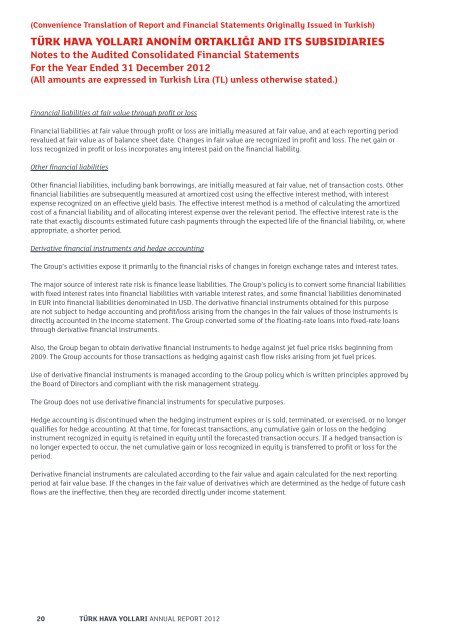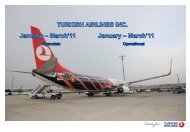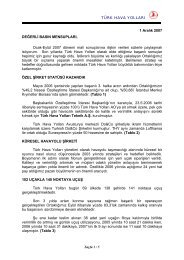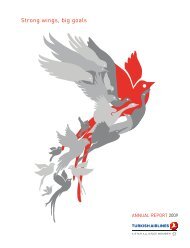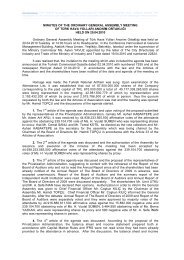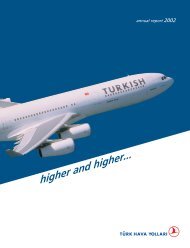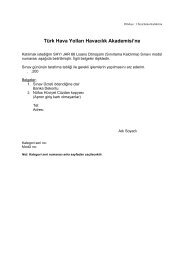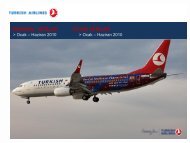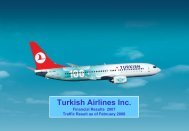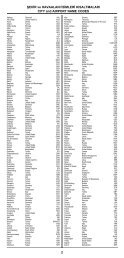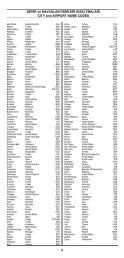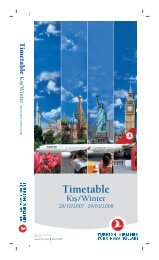Financial - Turkish Airlines
Financial - Turkish Airlines
Financial - Turkish Airlines
- No tags were found...
Create successful ePaper yourself
Turn your PDF publications into a flip-book with our unique Google optimized e-Paper software.
(Convenience Translation of Report and <strong>Financial</strong> Statements Originally Issued in <strong>Turkish</strong>)TÜRK HAVA YOLLARI ANONİM ORTAKLIĞI AND ITS SUBSIDIARIESNotes to the Audited Consolidated <strong>Financial</strong> StatementsFor the Year Ended 31 December 2012(All amounts are expressed in <strong>Turkish</strong> Lira (TL) unless otherwise stated.)<strong>Financial</strong> liabilities at fair value through profit or loss<strong>Financial</strong> liabilities at fair value through profit or loss are initially measured at fair value, and at each reporting periodrevalued at fair value as of balance sheet date. Changes in fair value are recognized in profit and loss. The net gain orloss recognized in profit or loss incorporates any interest paid on the financial liability.Other financial liabilitiesOther financial liabilities, including bank borrowings, are initially measured at fair value, net of transaction costs. Otherfinancial liabilities are subsequently measured at amortized cost using the effective interest method, with interestexpense recognized on an effective yield basis. The effective interest method is a method of calculating the amortizedcost of a financial liability and of allocating interest expense over the relevant period. The effective interest rate is therate that exactly discounts estimated future cash payments through the expected life of the financial liability, or, whereappropriate, a shorter period.Derivative financial instruments and hedge accountingThe Group’s activities expose it primarily to the financial risks of changes in foreign exchange rates and interest rates.The major source of interest rate risk is finance lease liabilities. The Group’s policy is to convert some financial liabilitieswith fixed interest rates into financial liabilities with variable interest rates, and some financial liabilities denominatedin EUR into financial liabilities denominated in USD. The derivative financial instruments obtained for this purposeare not subject to hedge accounting and profit/loss arising from the changes in the fair values of those instruments isdirectly accounted in the income statement. The Group converted some of the floating-rate loans into fixed-rate loansthrough derivative financial instruments.Also, the Group began to obtain derivative financial instruments to hedge against jet fuel price risks beginning from2009. The Group accounts for those transactions as hedging against cash flow risks arising from jet fuel prices.Use of derivative financial instruments is managed according to the Group policy which is written principles approved bythe Board of Directors and compliant with the risk management strategy.The Group does not use derivative financial instruments for speculative purposes.Hedge accounting is discontinued when the hedging instrument expires or is sold, terminated, or exercised, or no longerqualifies for hedge accounting. At that time, for forecast transactions, any cumulative gain or loss on the hedginginstrument recognized in equity is retained in equity until the forecasted transaction occurs. If a hedged transaction isno longer expected to occur, the net cumulative gain or loss recognized in equity is transferred to profit or loss for theperiod.Derivative financial instruments are calculated according to the fair value and again calculated for the next reportingperiod at fair value base. If the changes in the fair value of derivatives which are determined as the hedge of future cashflows are the ineffective, then they are recorded directly under income statement.20 TÜRK HAVA YOLLARI ANNUAL REPORT 2012


